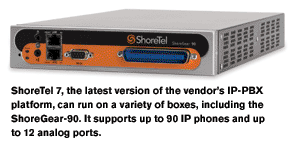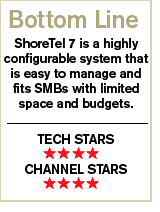Review: VoIP, Clean And Simple

One candidate worth considering is the latest version of ShoreTel's IP-PBX platform.
CRN Test Center engineers deployed ShoreTel 7 on a new ShoreGear-90 switch with the vendor's IP phones. ShoreTel 7 offers many features, easily supporting remote workers, allowing mobile users to assign their extensions to phones at temporary locations and maintaining dial tone and phone book access within the remote offices even if the network connection with the head office is down.

A new feature is escalation notification, which allows administrators to define a response process for incoming calls. Depending on the business rule, the voice mailbox can call a different phone or pager, transfer the call to an operator or an alternate group member or put the call in a group queue. The system tries to find the recipient or an alternate person before shunting them to voice mail—ideal for a service-oriented organization.
ShoreTel's switches support both analog and IP lines. The switches also have two failover ports that provide dial tone for analog phones in case of a network outage. The 1U boxes come with an Ethernet port in the front for direct connection in maintenance. The ShoreGear-90's footprint is small; two fit comfortably on one rack tray, providing more support for phones in the same space—a boon for SMBs with tight rack constraints. The ShoreGear-90 supports up to 90 IP phones and up to a maximum of 12 analog ports. Smaller and larger versions are also available.
ShoreTel 7 carries strict hardware requirements, currently requiring Windows 2003 server with IIS components turned on. It currently has no support for 64-bit.

The vendor recommends a dedicated server to handle voice and telephony functions. Engineers initially attempted to deploy on a Gateway quad-core server running Windows 2003 and MediaWiki. The installer failed with a cryptic error because of the existing MySQL database installation used by MediaWiki, and there were no workarounds, such as installing the remaining components and requiring the administrator to use the existing database to create the necessary schema and tables. The deployment went quickly once it was installed onto a clean server. The installer also performs a check to determine any missing components and prompts the user to install them before continuing, such as IIS components and the latest version of the Microsoft Jet Engine.
The ShoreTel box has two Ethernet ports on the front panel to connect the switch to the network. A maintenance port connects a standard VGA monitor to directly access the switch's configuration settings. Engineers used the maintenance port to manually set the switch's IP address. There's also an audio input port to pipe hold music into the system, as well as an output port that can be hooked up to a speaker/intercom system.
The company is extremely channel friendly, selling exclusively through partners. Its single-tier channel program costs approximately $10,000 to join. The vendor requires an annual quota from its partners, which varies by region. ShoreTel restricts the number of partners in each region, giving providers a larger sales territory to work with.
ShoreTel estimates that partners make 35 percent margins. Solution providers can tap other revenue opportunities by developing communications applications to enhance the VoIP solution. With ShoreTel's SDK, partners can create hooks for the ShoreTel 7 system to tie into other custom applications.
ShoreGear-90 retails for $4,195. Software upgrades are free for customers with maintenance contracts.